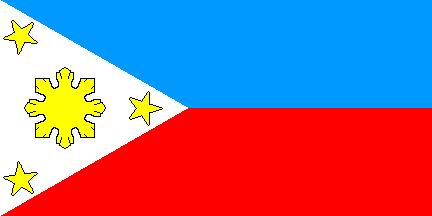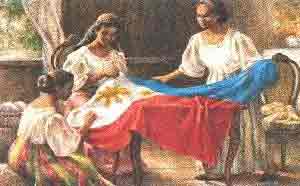|
Flag and national anthem of the Philippines
Also the Philippine flag, belonging to the most beautiful flags, has a history and historical precursors. Some of these precursors designed in time of the early Philippine independence movement you will find below:
Before 1898 there was no standardized flag in general use. The three "KKK" are abbreviations letters for Kataas-taasang Kagalang Katipunan ng mga Anak ng Bayan" (The highest and most respectable union of the sons of the people). This secretly operating movement operated under the leadership of Andreas Bonifacio, who propagated - unlike the Liga Filipina founded by Rizal - the armed resistance against the Spanish colonial regime. Later flags show no "KKK" anymore. Now a mythological sun in different forms symbolizing the national awakening and progress takes the place of the former letters. The eight sunrays represent the eight provinces (Manila, Bulacan, Tarlac, Pampanga, Nueva Ecija, Laguna, Batangas and Cavite), which rebelled against the colonial power and consequentially were submitted under the Spanish martial law. Today's flag of the Philippines has its birth hour in 1897, when General Emilio Aguinaldo stayed in exile in Hong Kong. May be that the designers have been inspirited by the triangle and blue color of the Cuban flag, which shows some similarities:
Interpretation of the flag
The Philippine national flag shows in horizontal line two ribbons in blue and red color. In periods of peace -- and this is a peculiarity of the Philippine flag the blue ribbon appears, in times of war the red ribbon is above. The last time the "war flag" was hoisted in 1987, when Gregorio "Gringo" Honasan instigated a vain putsch against the government. The blue stripe symbolizes the unity of the country and ethical Principles like peaceableness, love of truth and justice. The specific color of blue varied over the years. First it was the "Cuban Blue" of the Cuban flag. In 1919 only the darker "Navy Blue" of the American flag was available. Then in time of president Marcos there was again a change to the brighter "Cuban Blue" and in 1998 Corazon Aquino opted after a long debate for "Royal Blue". The current flag shows the color of "Royal Blue". The red stripe stands for the patriotic courage and bravery of the population, while the white triangle symbolizes equality and fraternity. We mentioned already the yellow sun and its symbolism. The eight beams embody the eight rebellious provinces. In 1998 the province of Zambales claimed also a sunbeam in the flag. But this wish was refused. Historians investigated that the province of Zambales has not been submitted under martial law by the Spaniards. The three little corner stars represent the geographical areas of Luzon, Visayas and Mindanao. The Philippine national anthem In 1898 general Emilio Aguinaldo recognized the necessity for a national hymn and he assigned the music teacher and composers Julian Felipe to compose a hymn. He rejected a former proposal for a hymn, because this music was not solemn and majestic enough. Already after six days Felipe ended his work. At his première in June 1898 the march found an enthusiastic reception and standing ovations by the broader audience and the circle of political executives. However a text for the hymn was missing for over a year. The 23-year-old soldier Jose Palma formulated the text in Spanish language. In his text the author praises the glowing patriotism, pride and desire for freedom of his compatriots. The text does not mobilize aggressive feelings against other countries, but its dramatic wording seems to be a little bit strange in our rational times. On the other side nearly all national anthems of the 19th century show dramatic emotions. In the first decades of American colonial regime the singing of the anthem was not allowed. Later in the twenties - the text was translated into the Tagalog and in the English language. The last revision of text was written in 1956 by representatives of the National Language Institute. Here the "English version" of the text by Camilo Osias and A. L. Lang: Land of the morning
© Wolfgang Bethge, in 2003 |








 The
three - in the vicinity of General Aguinaldo living women needed five
days to sew the embroideries in the silk flag. There are reports, that
they needed a lot of patience to find the right proportions and lines. The
flag was the first time shown to the public on May 28th, 1889. It is
todays day of flag. On June 12th, 1889 it was declared as the official
flag of the first republic. There are two phases in the Philippine
history, when the hoisting of flag which was also a symbol for national
resistance - was not allowed and was punished. Under the American colonial
regime it was the time from 1907 1919. The Japanese troops prohibited
the flag from 1941 1943. Because still deviations in form could still be
found, president Quezon issued in 1936 a decree, which determined
meticulously the proportions, lengths scales and angles of the flag.
The
three - in the vicinity of General Aguinaldo living women needed five
days to sew the embroideries in the silk flag. There are reports, that
they needed a lot of patience to find the right proportions and lines. The
flag was the first time shown to the public on May 28th, 1889. It is
todays day of flag. On June 12th, 1889 it was declared as the official
flag of the first republic. There are two phases in the Philippine
history, when the hoisting of flag which was also a symbol for national
resistance - was not allowed and was punished. Under the American colonial
regime it was the time from 1907 1919. The Japanese troops prohibited
the flag from 1941 1943. Because still deviations in form could still be
found, president Quezon issued in 1936 a decree, which determined
meticulously the proportions, lengths scales and angles of the flag. 